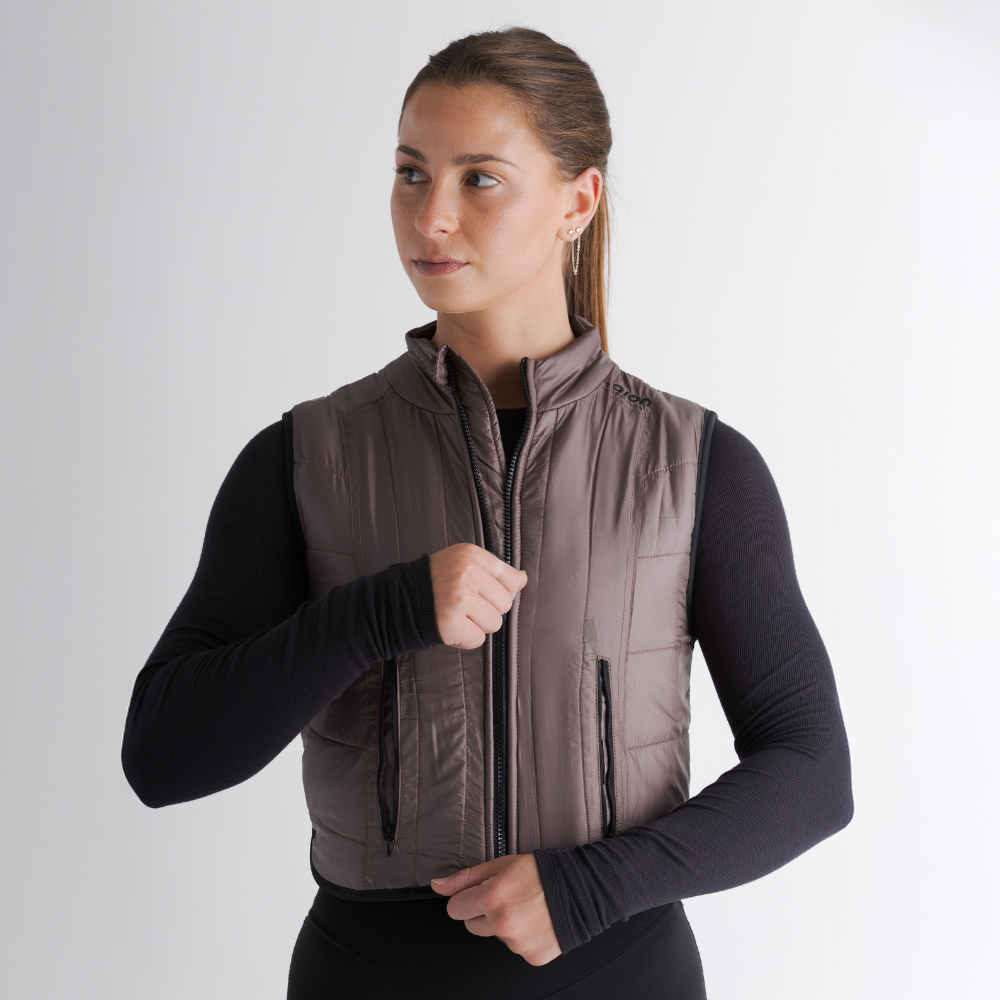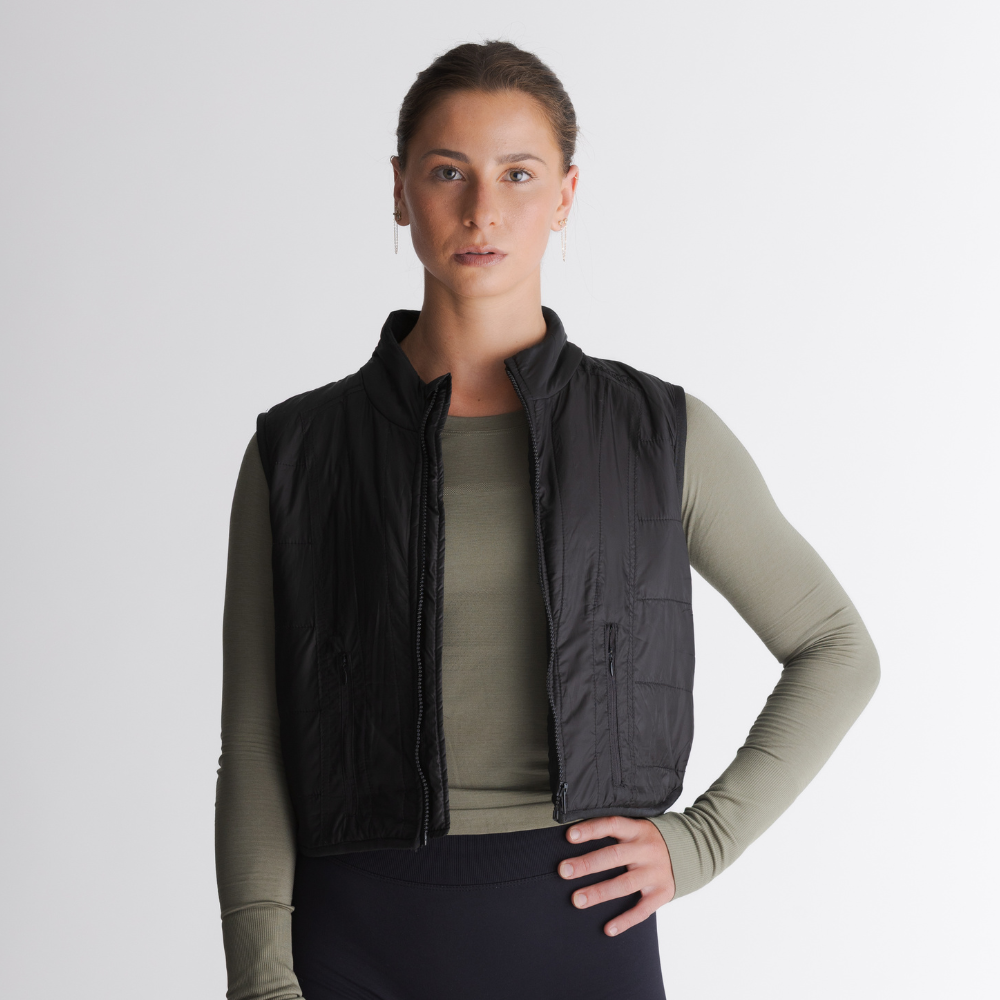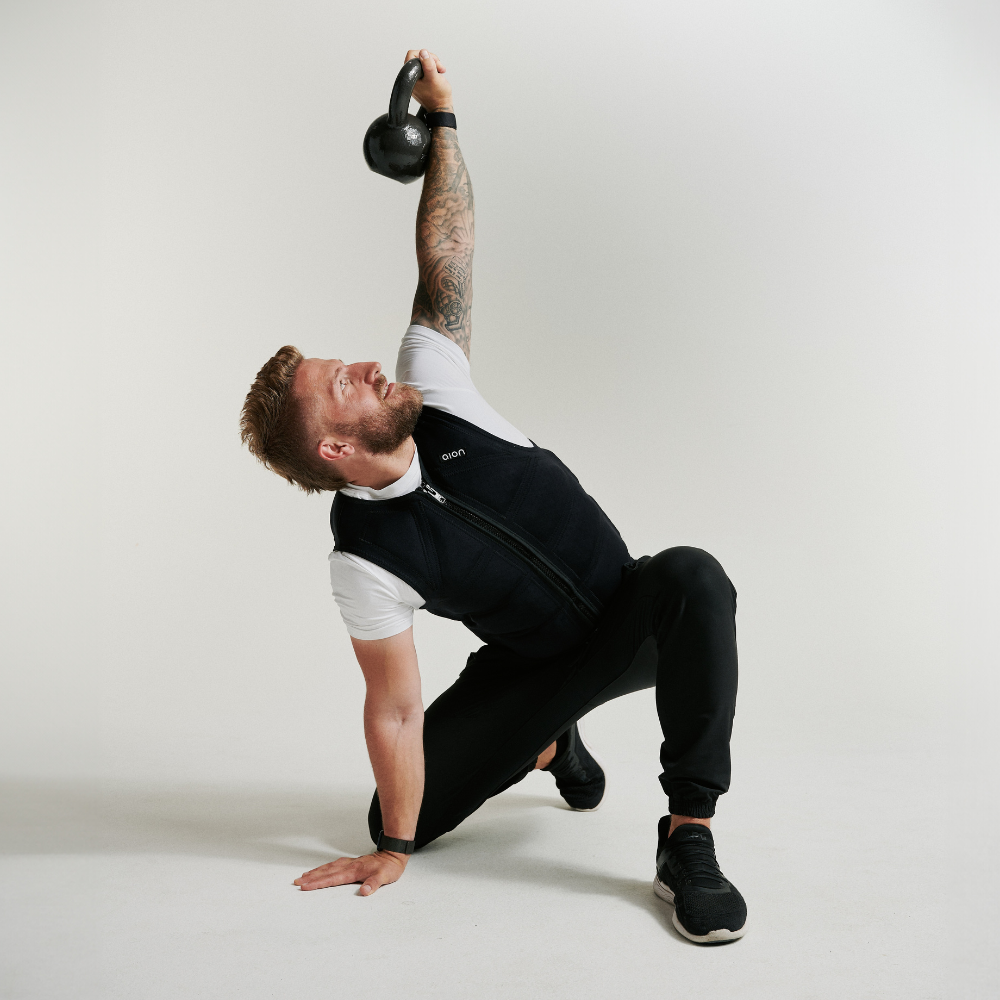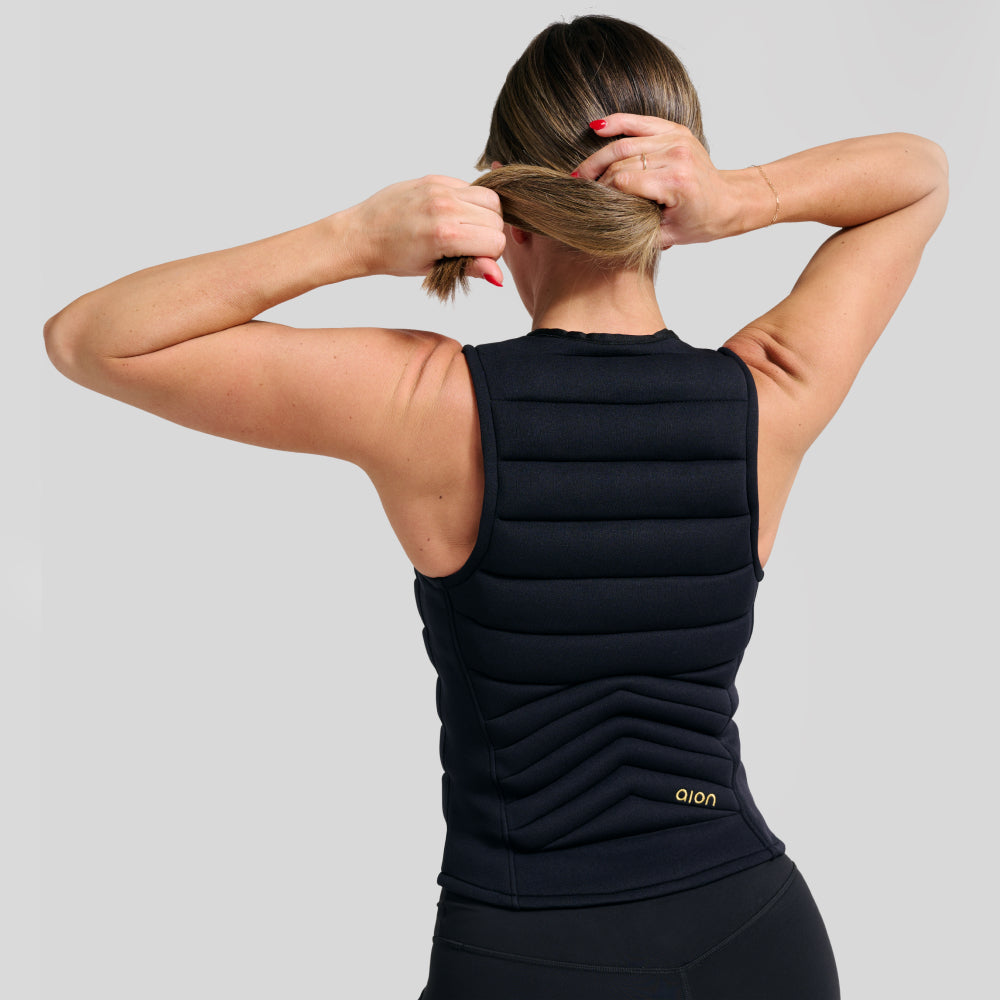HYROX is the hottest event in fitness right now. This global race blends functional strength training with endurance running, creating what many call the ultimate test of hybrid fitness. Consisting of eight workout stations, each separated by a 1-kilometer run (just over half a mile), HYROX is an intense, full-body challenge that even elite athletes find difficult. Regardless of your fitness level, you need a solid HYROX training plan to prepare you for success on race day.
Crushing HYROX demands more than raw strength or speed—it demands precision, pacing, and purpose-built training. Whether you’re a first-timer or gunning for a personal best, you need a HYROX workout plan that focuses on perfecting the movements, managing your pacing, and building strength.
There's one powerful, often-overlooked upgrade you can make to supercharge your performance: training with a weighted vest. Adding a vest to your workouts can help simulate race-day fatigue, build muscular and cardiovascular endurance, and sharpen your mental edge.
In this guide, we’ll walk you through a full HYROX training strategy that integrates Aion weighted vests into each station, helping you train smarter, push harder, and perform better.
All You Need to Know About HYROX 
To be successful in training for your next HYROX event, you must first understand how the race works. For the complete primer, visit the event website here. Essentially, the HYROX format looks like this:
- Run - 1 km (0.62 mi)
- Station 1: SkiErg - 1 km (0.62 mi)
- Run - 1 km (0.62 mi)
- Station 2: Sled Push - 50 m (55 yd)
- Run - 1 km (0.62 mi)
- Station 3: Sled Pull - 50 m (55 yd)
- Run - 1 km (0.62 mi)
- Station 4: Burpee Broad Jumps - 80 m (87 yd)
- Run - 1 km (0.62 mi)
- Station 5: Rowing - 1 km (0.62 mi)
- Run - 1 km (0.62 mi)
- Station 6: Farmer’s Carry - 200 m (219 yd)
- Run - 1 km (0.62 mi)
- Station 7: Sandbag Lunges - 100 m (109 yd)
- Run - 1 km (0.62 mi)
- Station 8: Wall Balls - 100 reps
You can participate individually in the Open category for standard weights or as a Pro for heavier weights. You can also opt for the group categories: Doubles (for 2 participants) or Relay (for 4 participants), and take on the challenges as a team with other people. The event takes place indoors, making it a year-round competitive option.
HYROX offers a structured, challenging, and exciting way to compete. However, don’t make the mistake of thinking the race is a walk in the park. Each station, plus a total running distance of 8 km (5 miles), may seem easy if you complete them in isolation, but cumulative fatigue and transition demands make these activities extra challenging to complete.
The Training Strategy You Need to Master HYROX (that Nobody is Talking About)
To truly dominate HYROX, it requires more than just physical readiness—it demands a strategic mindset. With that in mind, we spoke with Aion's vest engineer and mental coach, Al Fuentes—a former 2x All-American Collegiate Wrestler, 3x Academic All-American and National Qualifier in Pole Vault, and experienced mental coach to a wide variety of professional athletes—to get his expert take on the mental and physical training necessary for HYROX.
Al shares a profound philosophy for unparalleled HYROX preparation. His approach centers on training not just for the movements, but for the physiological conditions of the race, grounded in two critical pillars: mastering technique and intentionally training with oxygen deficiency.
Pillar 1: Technique First, Always
Before pushing your limits or adding significant load, mastering the technique of each HYROX movement is paramount. Al emphasizes that your first round of training for any station should always be dedicated to perfect form.
Meticulously record yourself, watch your posture and movement patterns, and ensure every rep is clean and efficient. This creates a solid baseline and muscle memory that will serve as your unshakeable foundation under pressure.
Pillar 2: Train with Oxygen Deficiency to Simulate Race Fatigue

Once technique is dialed in, Al advocates for a strategic approach to simulating race-day fatigue: training with an oxygen deficiency. As the HYROX race progresses, the 1-kilometer runs between stations mean you'll be performing strength movements with progressively less oxygen in your system. To prepare for this reality, Al recommends intentionally exhausting your body prior to isolating and performing each workout station.
In your HYROX training, this can be achieved through short, intense bursts of cardio, like a quick quarter-mile (400m) sprint or a challenging set of burpees, performed just before you tackle a specific station's exercise. By taking oxygen out of your system beforehand, you force your body to adapt in real-time, increasing your oxygen use efficiency (often referred to as VO2 max) and priming your muscles for the real demands of the race. The Aion weighted vest becomes an invaluable tool here, amplifying the effect of this pre-fatigue and making every movement under oxygen debt even more impactful, forcing deeper physiological adaptations.
Pillar 3: Elevate Your Endurance with Strategic Overload
Beyond isolated station work, Al also advises pushing your overall endurance capacity with strategic overload in your running. Once per week, consider performing the full HYROX circuit, but extend your runs to 1600 meters (1 mile) instead of the standard 1000 meters (1 km). This builds a deeper aerobic base and prepares your body for extended periods of exertion.
Additionally, incorporate dedicated sessions of 20 quarter-mile (400m) sprints to significantly improve your anaerobic capacity and speed under duress, further building your resilience for the repeated efforts of the race.
HYROX Training with a Weighted Vest
One of the best ways to level up your training before race day is by using a weighted vest. When paired with the strategy outlined above, a weighted vest like Aion helps prepare you for the compound fatigue effect. That’s the feeling on race day when everything feels harder because your body is already taxed from the last movement. HYROX training with Aion helps to simulate race day fatigue, allowing your body to naturally become stronger against it. (Just imagine, you’re used to doing the HYROX circuit with a weighed vest so it feels A LOT easier when you’re doing it without a vest on race day!)
With the Aion Weighted Vest, you have a game-changing edge that includes:
- Boost in muscle and cardio endurance under fatigue
- Reinforced posture and form against load
- Increased strength against fatigue, for smoother transitions
- Improved mental toughness for resilience against repetitive tasks
Our conducted research study, utilizing WHOOP Wearable Bands and force plate technology, revealed remarkable results that underscore Aion's effectiveness. Users wearing an Aion vest saw a +69% increase in caloric expenditure during HIIT workouts compared to training without, alongside a +20% higher average heart rate in the same sessions. This concrete data demonstrates how Aion significantly elevates cardiovascular demands, boosts endurance, and accelerates your metabolic rate, giving you a proven edge in high-intensity challenges like HYROX. Unlike other training gear, Aion’s weighted vest is versatile and allows for fluid, unrestricted movement. This makes it ideal for training for both running and functional exercises.
Mastering the 8 HYROX Stations with a Weighted Vest
Now that you understand the powerful principles behind Aion-enhanced HYROX training—including Al Fuentes's strategic insights into technique and oxygen deficiency—let's dive into how to tackle each station. When performing these station-specific drills, consider applying Al Fuentes's principle of oxygen deficiency by doing a short, intense sprint or burpee set with your Aion vest immediately prior to the station workout.
Station 1. SkiErg
Using a SkiErg allows for a full-body, low-impact workout. In this station, you need to focus on your rhythm and power. However, doing this can be harder after the fatigue from the previous 1-km run.
When you train with a weighted vest, you amplify your core and upper body engagement, especially in the lats and triceps. Ultimately, training your body to overcome race day fatigue.
Workouts using a weighted vest:
- 5 rounds of 200 m (219 yd) SkiErg sprints to build strength and endurance
- 4 rounds of 1 min jumping rope + 1 min SkiErg
Station 2. Sled Push

Perhaps the most infamous of the 8 stations, the sled push demands brute strength, explosive drive, and incredible grit. A weighted vest allows you to train your legs against fatigue and enhances your ability to maintain tension over time. Remember to keep your torso upright and engage your core, this is essential for training proper posture under load.
Workouts using a weighted vest:
- 3 rounds of 20 m (22 yd) sled push intervals
- Superset (transition between exercises without taking a break) sled push with 15-minute walking lunges. This helps train against transition fatigue.
- Bulgarian split squats: 3 rounds of 10 reps per leg
Station 3. Sled Pull
This station requires posterior strength and coordination, both of which can be reinforced with a weighted vest. The added resistance from a weighted vest helps you get the most out of your pull-simulating and core-dominant movements. The goal is to reinforce your pulling mechanics and optimize your total-body stabilization under stress.
Workouts using a weighted vest:
- Bear crawl pulls, to simulate pulling resistance using bands anchored to a sled
- Renegade rows + plank holds, for a next-level core and back challenge
Station 4. Burpee Broad Jumps
Explosive and relentless, this station combines cardio and plyometrics, aka jump training. Training with the Aion workout vest, which is optimally weighted to tax your muscles without sacrificing form, makes your jump mechanics more powerful and efficient when the vest comes off. Workouts with a weighted vest enhance plyometric strength and explosive power, while also improving the ability to recover more quickly during transitions.
Workouts using a weighted vest:
- 3 rounds of 10 reps of burpee broad jumps
- 3 sets of 20 Jump Squats + 40 Mountain Climbers
- Weighted Lateral Bounds for instability and coordination practice
Station 5. Rowing
Similar to the SkiErg, rowing tests your rhythm, core strength, and posterior endurance. Using a vest while rowing simulates fatigue and helps condition your body for the later stages of the race. This builds your efficiency in rowing while fatigued and elevates your postural strength.
Workouts using a weighted vest:
- 5 rounds of 200 m (219 yd) rowing sprints
- 10 minutes EMOM (every minute on the minute) with 1 minute row + 10 pushups
- 1 km row immediately after weighted circuit work
Station 6. Farmer’s Carry
At this station, grip, traps, and mental strength all come into play. In isolation, the farmer’s carry appears simple, but this workout can easily turn into a nightmare when combined with distance and fatigue. When you train beforehand with a weighted vest, you add passive load and simulate the strain of the race. Training with a weighted vest helps improve endurance and core integrity while loaded.
Workouts using a weighted vest:
- 3-5 rounds of 100-m (109 yd) dumbbell farmer’s carries
- Suitcase carries or single-arm loaded walks for core activation
- 3 sets of 1-minute maximum load hold
Station 7. Sandbag Lunges
Your legs are nearly cooked by the time you get to this station. Lunges test unilateral strength, balance, and mental toughness. Adding a vest makes this movement more demanding and makes you even more effective on race day. Training with a weighted vest will help you build strength in your glutes and quadriceps while reinforcing balance and posture.
Workouts using a weighted vest:
- 3-4 rounds of 20 m (22 yd) walking lunges
- 3-4 rounds of 20 m (22 yd) reverse lunges with twist, to add rotational core stimulus
- Split squats: 3 sets of 10 reps per leg
Station 8. Wall Balls
The final station, doing 100 wall balls, is where most athletes figuratively hit the wall. By this time, your shoulders are smoked, your legs are trembling, and your heart is pounding. Training with a weighted vest will condition you for this high-rep finisher. The weighted vest will prepare your body to perform under extreme fatigue and reinforce the consistency in your movements.
Workouts using a weighted vest:
- 4 sets of 25 reps of wall balls, keeping focus on breathing
- 3 sets of 15-20 reps of thrusters while using a dumbbell or medicine ball
- 3 rounds of wall sit hold (30s) + wall balls (20)
Level Up Your HYROX Training with Weighted Vest Running
While training for each station is important, don’t forget that in between each station lies a 1 km (0.62 mi) run. Thus, it is equally important to train your ability to recover and maintain pace under fatigue. Wearing an Aion vest during run sessions can teach your body how to breathe and move efficiently when tired, simulating race-day demands.
For even greater endurance gains, consider Al Fuentes' advice: once or twice a week, extend your in-between station runs to 1600 meters (1 mile) during a full circuit simulation, or incorporate intense sessions of 20 quarter-mile (400m) sprints with your vest to build unparalleled anaerobic capacity and speed under duress.
Try this hybrid run circuit using a weighted vest:
- 1 km (0.62 mi) run
- 10 burpees + 10 lunges
- Rest 2 minutes
- Repeat 3–4 rounds
Start with shorter distances while wearing a weighted vest, increasing gradually until you can make longer runs. Running 5-8 km (3-6 mi) with a weighted vest once per week is excellent for building aerobic base and posture awareness.
Weekly HYROX Training Plan with a Weighted Vest
This comprehensive weekly training plan integrates Aion weighted vests with the advanced strategies from Aion's vest engineer and mental coach, Al Fuentes. It's designed to build not just your physical capacity, but also your mental resilience by training you for the specific demands of a HYROX race.
Before pushing your limits or adding significant intensity, dedicate your first round of any new exercise or station practice to mastering perfect technique. Focus solely on form, posture, and efficient movement. Record yourself if possible, review, and refine until your movements are clean. This establishes your crucial baseline.
Monday: Strength & Pull Focus
- Pre-Fatigue: Begin with a 400-meter (¼ mile) sprint OR 20 burpees (wearing your Aion vest if comfortable and form is maintained).
-
Workout:
- Deadlifts: 3-4 sets of 5-8 reps (Focus on perfect form)
- Rowing intervals with Aion vest: 5 rounds of 200m sprints
- Bear Crawls with Aion vest: 3 sets of 20m
- Plank Holds with Aion vest: 3 sets, hold for 45-60 seconds
- Mountain Climbers with Aion vest: 3 sets of 30-45 seconds
- Post-Workout: Active recovery stretches.
Tuesday: Running & Lower Body Power
- Pre-Fatigue: Start with a 400-meter (¼ mile) sprint OR 20 burpees (wearing your Aion vest if comfortable).
-
Workout:
- Extended Run Simulation: 2-3 rounds of 1600-meter (1 mile) run with Aion vest.
- Step-ups (onto a box/bench): 3 sets of 10-15 reps per leg (consider holding light dumbbells).
- Sled Push: 3-4 rounds of 20-30m intervals (focus on maintaining tension).
- Wall Sits with Aion vest: 3 rounds of 1-minute holds.
- Post-Workout: Mobility work focusing on hips and quads.
Wednesday: Active Recovery & Mobility
- Easy jog, cycle, or swim (30-45 minutes).
- Dynamic stretching and mobility exercises (20-30 minutes).
- Optional: 20-minute leisurely walk with your Aion vest for gentle active recovery and posture reinforcement.
Thursday: Race Simulation & Station Drills
- Pre-Fatigue: For each station drill you perform this day, precede it with a 400-meter (¼ mile) sprint OR 20 burpees (wearing your Aion vest).
-
Workout (Focus on Transitions & Pacing):
- 1 km run (warm-up).
- 3 rounds of SkiErg (1km) + Sled Push (50m) combo.
- Optional Aion Vest use: Depending on fatigue levels, use your Aion vest during these combo drills to further simulate race conditions.
- Post-Workout: Light stretching and self-assessment of technique under fatigue.
Friday: High-Intensity Hybrid Routine
- Pre-Fatigue: Begin with a 400-meter (¼ mile) sprint OR 20 burpees (wearing your Aion vest if comfortable).
-
Workout (Perform as a circuit or supersets):
- Burpee Broad Jumps: 3 rounds of 10-15 reps with Aion vest.
- Farmer’s Carry (with dumbbells or kettlebells): 3-4 rounds of 100m.
- Wall Balls: 3-4 sets of 20-30 reps (focus on consistent reps and breathing).
- 1 km run intervals: 2-3 intervals (perform between circuits or at the end).
- Post-Workout: Foam rolling and static stretching.
Saturday: Long Run & Skill Drills / Anaerobic Boost
- Morning: 5–8 km (3-6 mi) easy run (Aion vest use optional, focus on aerobic base and recovery).
-
Afternoon/Later:
- Skill Drills: Practice technique for rowing, SkiErg, and transitions (focus on form, not necessarily with vest).
- Anaerobic Boost: Complete 20 quarter-mile (400m) sprints. Rest adequately between sprints, focusing on maximal effort.
- Post-Workout: Comprehensive stretching and cool-down.
Sunday: Full Rest and Recovery
-
Allow your body to fully recover. Focus on optimal nutrition, hydration, and quality sleep to prepare for the week ahead.
Advanced Challenge: The Full Race Circuit with Extended Runs
For athletes looking to push their limits and truly replicate race-day conditions, Al Fuentes recommends periodically tackling the full HYROX circuit with extended runs. This demanding session is designed to build unparalleled endurance, mental fortitude, and test your ability to perform under sustained, race-specific fatigue.
- When to incorporate: This advanced session can replace your Saturday "Long Run & Skill Drills" if you're feeling strong and well-recovered, or be incorporated every few weeks as a benchmark and peak conditioning workout. It's a significant commitment and should not be attempted if you're fatigued or new to HYROX training.
-
The Workout:
- Perform the entire HYROX race format, completing all eight runs and all eight workout stations in sequence.
- The twist: For each of the eight run segments, extend the distance from 1000 meters (1km) to 1600 meters (1 mile).
- Wear your Aion Weighted Vest throughout the entire circuit. The Dynamic Resistance™ technology, compression, and heat capture of your Aion vest will amplify the challenge, simulate race load, and maximize the training effect on your cardiovascular system and muscular endurance under extreme fatigue.
This ultimate simulation will not only build immense physical capacity but also sharpen your pacing strategies, fortify your mental toughness, and prepare you for the unique cumulative demands of dominating HYROX. Listen intently to your body, prioritize hydration throughout, and ensure adequate recovery following this demanding session.
Dominate HYROX with an Aion Weighted Vest
Aside from strength and speed, HYROX success lies in your resilience, adaptability, and the ability to push through fatigue when your body is begging you to stop. That’s exactly what Aion Weighted Vests help you train for.
Including Aion in your HYROX workout plan makes you train harder and, consequently, you make yourself stronger, more efficient, and more mentally equipped to handle the grind of eight stations and eight runs.
With Aion’s Dynamic Resistance™ technology, you get weight resistance, compression, and heat capture all working together to prepare you for the finish line. All this while promoting natural movement: you can sprint, row, lunge, and jump without affecting posture or risking injuries because the Aion vest is optimally weighted and secure on your core.
So if you’re serious about showing up strong and finishing fast, it’s time to level up your prep. Train heavy but move free. Visit our shop and dominate HYROX with Aion today!
Disclaimer: The training plan and workout suggestions provided in this guide are for general informational purposes only and are designed as a template. Working with a physical therapist or certified personal trainer who can assess your individual fitness level and health condition is an excellent way to receive personalized guidance based on your strengths and weaknesses. As you prepare for a HYROX race, it is crucial to ensure your training is safe and effective for your specific needs. Always prioritize proper form and listen to your body.









